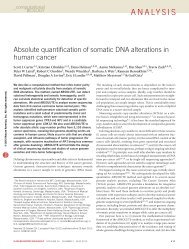Poster Session I (PI 1-106)Displayed 8:00 am – 3:00 ... - Nature
Poster Session I (PI 1-106)Displayed 8:00 am – 3:00 ... - Nature
Poster Session I (PI 1-106)Displayed 8:00 am – 3:00 ... - Nature
Create successful ePaper yourself
Turn your PDF publications into a flip-book with our unique Google optimized e-Paper software.
aBsTraCTs nature publishing group<br />
subjects after coadministration of NER+RIF. The most common<br />
on-treatment AEs were diarrhea (n=8 [33%], oropharyngeal pain<br />
(6 [25%]), and seborrhoeic dermatitis (2 [8%]). There were no AErelated<br />
discontinuations. As a result of rif<strong>am</strong>pin’s induction effect, during<br />
coadministration, NER C max and AUC substantially decreased to<br />
24.1% and 12.7%, respectively, of values observed with NER alone;<br />
correspondingly, NER metabolite C max was significantly increased by<br />
about 2.3-fold for M3, 1.5-fold for M6, and 1.4-fold for M7 compared<br />
with values after administration of NER alone.<br />
CONCLUSION: The results indicate that NER, a substrate<br />
of CYP3A4, is susceptible to interaction with potent CYP3A4<br />
inducers.<br />
<strong>PI</strong>-92<br />
USE OF A PHARMACOKINETIC-PHARMACODYNAMIC<br />
(PKPD) MODEL FRAMEWORK IN THE DESIGN OF A DOSING<br />
REGIMEN FOCUSED ON RESPONSE. A. Grover, L. Z. Benet; University<br />
of California, San Francisco, San Francisco, CA. A. Grover:<br />
None. L.Z. Benet: None.<br />
BACKGROUND: Grover and Benet (J Pharmacokinet Pharmacodyn<br />
(2011)) argue that pharmacokinetic dosing interval predictors<br />
will be more relevant for direct PKPD model drugs than they will be<br />
for indirect PKPD model drugs. As the direct-indirect distinction is<br />
actually a continuum, we sought to determine if a pattern in PKPD<br />
model par<strong>am</strong>eters (k e0 and k out for the indirect link (IDL) and indirect<br />
response (IDR) models, respectively) can be discerned to be used as<br />
additional guidance in determining a dosing regimen.<br />
METHODS: The relevance of pharmacokinetic dosing interval predictors<br />
was determined as the ratio of the longest recommended dosing<br />
interval to the time plasma concentrations are over an efficacy EC 50 .<br />
Using a number of case studies from the literature, we simulated the<br />
time plasma concentrations are above the EC 50 during multiple dosing<br />
steady state at the second to lowest approved dose and at the longest<br />
recommended dosing interval.<br />
RESULTS: The relationship between the ratio of the dosing interval<br />
to time above EC 50 and k e0 or k out is approximately log-linear (r 2 =<br />
0.750, p < 0.<strong>00</strong>1, n = 15), and a k e0 or k out value greater than 2 hr -1 (e.g.<br />
terbutaline, atropine, ranitidine) provides a dosing interval predicted<br />
by the pharmacokinetics. A finding that k e0 or k out is below 0.5 hr -1<br />
(e.g. terazosin, dex<strong>am</strong>ethasone) indicates that pharmacokinetic dosing<br />
interval predictors will not be clinically relevant. By combining efficacy<br />
and toxicity PKPD models for a single drug (here, levodopa), we<br />
show that this regression can be used to design a dosing regimen such<br />
that efficacy falls along the regression and toxicities appear underdosed.<br />
CONCLUSION: As a basic PKPD model should be derived early<br />
in clinical trials, the log-linear regression can be used as a fr<strong>am</strong>ework<br />
within which to understand the relevance of pharmacokinetic dosing<br />
interval predictors and as a guide for determining dosing regimens that<br />
are considerate of efficacious and toxic response for both IDL and IDR<br />
model drugs.<br />
<strong>PI</strong>-93<br />
ORAL MIDAZOLAM (MDZ) PARTIAL AREA-UNDER CURVE<br />
(AUC) DOES NOT RELIABLY PREDICT CYTOCHROME P450<br />
(CYP) 3A BASELINE ACTIVITY IN HEALTHY SUBJECTS. W.<br />
Tai, 1 S. L. Gong, 1 S. M. Tsunoda, 1 H. E. Greenberg, 2 J. C. Gorski, 3<br />
S. R. Penzak, 4 S. A. Stoch, 5 J. D. Ma 1 ; 1 UCSD, Skaggs School of<br />
Pharmacy & Pharmaceutical Sciences, La Jolla, CA, 2 Department of<br />
Pharmacology and Experimental Therapeutics, Thomas Jefferson University,<br />
Philadelphia, PA, 3 Mylan Pharmaceuticals, Morgantown, WV,<br />
4 Pharmacy Department, National Institutes of Health, Bethesda, MD,<br />
5 Merck, Rahway, NJ. W. Tai: None. S.L. Gong: None. S.M. Tsunoda:<br />
None. H.E. Greenberg: None. J.C. Gorski: None. S.R. Penzak:<br />
None. S.A. Stoch: None. J.D. Ma: None.<br />
BACKGROUND: MDZ clearance (CL) and AUC INF are used as<br />
biomarkers to predict CYP3A activity. A recent study recommended<br />
a MDZ partial AUC from 2 to 4 hr to predict MDZ metabolic CL. We<br />
evaluated a partial AUC approach to predict MDZ CL and thus CYP3A<br />
activity during baseline conditions.<br />
METHODS: MDZ plasma concentrations from 116 healthy adults<br />
were obtained from seven published studies. Observed CL, AUC, and<br />
partial AUCs over several intervals were determined via noncompartmental<br />
analysis. Subject data were randomly divided into a training<br />
set (n=30) and a validation set (n=86). Linear regression analyses of<br />
log-transformed partial AUCs were performed using the training set.<br />
MDZ predicted CL was determined from the validation set. Backtransformed<br />
predicted CL was compared to observed CL. Bias and<br />
precision were evaluated by percent mean precision error (%MPE),<br />
percent mean absolute error (%MAE), and percent root mean square<br />
error (%RMSE).<br />
RESULTS:<br />
Model<br />
equation<br />
AUC 0-2 AUC 0-6 AUC 2-4<br />
-0.33*<br />
[log(AUC 0-2 )] +5.45<br />
-0.43*<br />
[log(AUC 0-6 )] +5.68<br />
-0.44*<br />
[log(AUC 2-4 )] +5.45<br />
r2 0.26 0.40 0.47<br />
Mean<br />
predicted<br />
CL<br />
113.04 L/hr 114.29 L/hr 113.27 L/hr<br />
Mean<br />
observed<br />
CL<br />
115.34 L/hr 115.34 L/hr 115.34 L/hr<br />
%MPE<br />
(±5%)<br />
-1.7 -0.7 -1.7<br />
%MAE<br />
(








